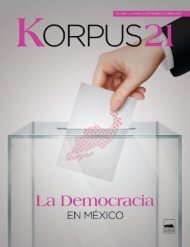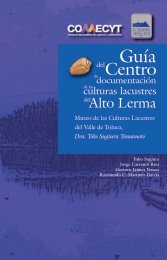Create successful ePaper yourself
Turn your PDF publications into a flip-book with our unique Google optimized e-Paper software.
MARY KAY VAUGHAN, EDUCATING THE SENSES: PEPE ZÚÑIGA AND MEXICO CITY’S REBEL GENERATION<br />
Introduction<br />
As a historian of modern Mexican education, I<br />
first published a monograph (1982) on educational<br />
policy and prescribed programs between<br />
1880 and 1928 and a second study (1997) on the<br />
subsequent time period (1930s) in which I examined<br />
educational policy implementation at<br />
the local level as it engaged teachers, parents,<br />
and political actors (Vaughan, 1982; Vaughan,<br />
1997). My subsequent proposal took up the following<br />
decades (1940s into the 1960s) and another<br />
dimension of education, that of student<br />
learning. I had come to realize that the history<br />
of education is overly narrow when confined to<br />
the formal classroom. I wished now to look at<br />
students’ learning experiences in school, family,<br />
friendships, neighborhood, the mass media, associations<br />
of different types (sports, religious),<br />
and events. Aside from the chronological continuity,<br />
I had other reasons to choose this period.<br />
This was my own generation. It was a revolutionary<br />
generation in Mexico City, the U.S., and elsewhere,<br />
not simply in politics but in self-expression.<br />
As schools were to prevent revolutions by<br />
channeling learning, how did this happen? I decided<br />
to focus on Mexico City where the strongest<br />
rebellion exploded in 1968. This book was<br />
published in 2015 as Portrait of a Young Painter:<br />
Pepe Zuniga and the Rebel Generation in Mexico<br />
City and in Spanish in 2019 (Vaughan, 2019).<br />
Into my sabbatical leave in Mexico in 2000<br />
I had not yet found my methodology, my subjects<br />
nor a common thread that might link a<br />
generation or at least a particular social sector<br />
with shared experiences. When I read Norbert<br />
Elias’s essay about West German rebel youth in<br />
the 1960s, I found a working framework (Elias,<br />
1998). I believed his observations applied to a<br />
broad swathe of youth across the “Western<br />
world” including the United States and parts of<br />
Latin America, particularly the larger countries<br />
with stable states supported by rapid economic<br />
growth, urbanization, and educational expansion.<br />
Elias argued that the generation that<br />
turned political in 1968 was the first in the 20 th<br />
century to escape war, depression, or political<br />
instability: children moved from a situation of<br />
want and displacement into one of market-driven<br />
consumption, familial security, and optimism<br />
about their personal happiness, goal-orientation,<br />
and democracy, fed by the Cold War’s heavy<br />
ideologization. Their parents were more lenient<br />
with their children than their parents had been.<br />
Children had the leisure time, the incentive, the<br />
permission, the means, and objects to play with.<br />
They took advantage of educational opportunity.<br />
When they ran up against what they perceived<br />
to be the anachronisms, restrictions, and<br />
discrimination of universities, families, and institutions<br />
controlled by their elders, they balked.<br />
In fact, as they experienced adolescence, the<br />
whole adult world seemed marked by repression,<br />
stuffiness, and corruption that clashed with<br />
the effervescence of a teeming youth culture<br />
forged in prolonged periods of time spent together.<br />
They rebelled, and their rebellion resonated<br />
across multiple spaces.<br />
So Elias had outlined the experience of a<br />
generation, which he more or less defined by<br />
time (childhood in the immediate post war), in<br />
space (Germany and Europe but extendable),<br />
by class (roughly middle class or aspiring to it);<br />
by education (a solid public school formation<br />
with increasing exposure to higher education),<br />
and by political empathy (attuned to liberation<br />
movements, decolonizing movements in Africa,<br />
Vietnam, and civil rights movements in the U.S.,<br />
etc., movements that allegedly democratic governing<br />
elites responded to with confusion, sabotage,<br />
violence and repression).<br />
But there was something central missing<br />
from this frame. Pepe Zuñiga inserted that for<br />
me. I first got to know Pepe during evenings<br />
with friends engaged in a sentimental journey<br />
into the popular music that had shaped their<br />
parents’ sensibilities and their own: Agustín Lara<br />
who sang seductive love songs over the radio<br />
and in film, Maria Luisa Landín, “Queen of the<br />
Bolero,” Manuel Esperón, who composed for<br />
movies, the band of Pérez Prado and Afro Cuban<br />
beats. They had learned this music from the<br />
radio, records, jukeboxes, film, and live theater.<br />
Now they created a middle age nostalgic return<br />
to the sweetest and most tender memories of<br />
childhood and youth, easy and pleasant to recall<br />
now as, with advancing age, so much of the<br />
hard-edged “struggle for life” was behind them.<br />
In its place, we shared an existential opening for<br />
the return of tenderness and innocence if only as<br />
a palpable memory, a feeling. Why do I include<br />
myself in the sharing? For that very reason: yes,<br />
114



![bicentenario_1[V2]](https://img.yumpu.com/68677971/1/167x260/bicentenario-1v2.jpg?quality=85)

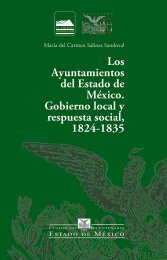

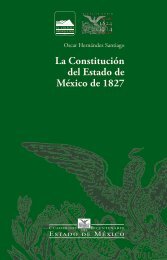

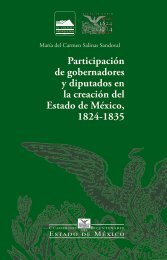
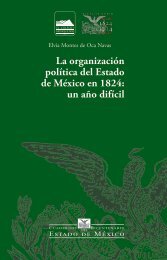

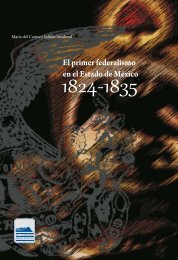
![El_primer_federalismoEM[final]_compressed (2)](https://img.yumpu.com/68483279/1/178x260/el-primer-federalismoemfinal-compressed-2.jpg?quality=85)
